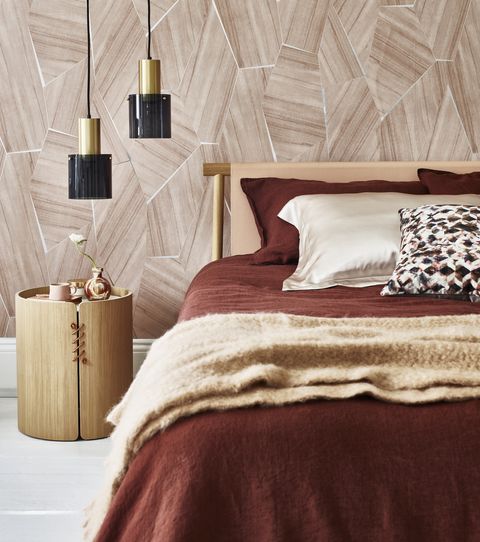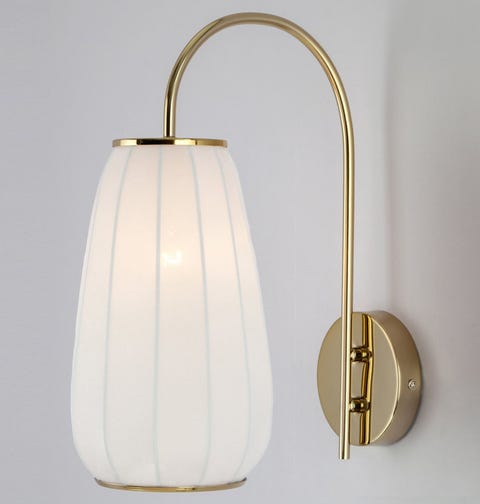Ceiling Lights, LED Lights, Fairy Lights
As well as a place to sleep in peace, our bedrooms often double up as a dressing room, home office and relaxation spot, so bedroom lighting has to work hard to create the right atmosphere for every activity.
Having multiple light sources gives you the widest-possible range of uses for the bedroom at all hours of the day (and night). Lighting experts recommend ‘layering’ using different sources of light to perform individual functions, coming together to create a pleasing overall scheme.
‘The key to producing the right balance is to layer your lighting correctly to provide a mixture of task, ambient and accent points, which are crucial in creating a calming space,’ says Peter Legg, new products development manager for där lighting group.
Task
Provides illumination for specific activities such as reading or applying make-up. ‘For example, if you’re a book lover, directional wall lights are far more effective than wall or table lamps with lampshades,’ says Rohan Blacker at lighting store Pooky.
Mood
Evokes a specific atmosphere and is achieved through use of shades, dimmer switches and coloured light bulbs. ‘Invest in good-quality light bulbs and be mindful of the wattage – 40 watts and below is ideal for creating a soft mood lighting,’ says Ben Stokes, founder and interior designer at KAGU Interiors. ‘The style of your light fittings may influence your choice of light bulb. Frosted glass works best for pendants and bedside lamps to diffuse the glow, while LED filament styles work perfectly with “naked bulb” designs.’
Accent
Draws the eye to a particular feature such as an attractive plant, artwork or mirror. For quick, affordable and stylish impact, drape fairy lights through foliage or around a frame.
TOP TIP: Always consider how much natural light is already available. Too many lighting pieces in a bedroom scheme can make the space appear cluttered and overwhelmed.
Consider these bedroom lighting ideas to help you achieve the perfect lighting scheme.
1) Bedroom ceiling lights
The ceiling light is usually the main light and typically the first switch you flick when you walk in. ‘The colour of the shade and bulb is very important as this really sets the mood,’ says Joel Chudleigh, director at Made to Last. ‘Black and dark colours give a sensual mood, blues and greens are relaxing and light-hearted. Pinks and reds bring energy and can also be relaxing and warm.’
What kind of impact do you wish to make? Elegant and classic or ahead of the curve? Tactile and natural materials are trending, and chandeliers never go out of fashion.
‘Statement lighting can bring a bedroom from zero to hero,’ says Owen Pacey, founder of antiques retailer Renaissance London. ‘Make sure your lights look just as cool turned off as they do when they’re turned on.’
He likes vintage lighting from the 1960s and 1970s: ‘It is almost always the most playful and interesting. It’s when big designers first started to introduce pops of colour with acrylic and blown glass in favour of traditional metals and crystals.’
The main light is often a central pendant, but for a streamlined minimalist look, consider recessed spotlights or downlights. Jamie Moxey, business development manager at Dusk Lighting, says that white fittings are easy to blend into the ceiling for a subtle look, whilst brushed or polished chrome recessed downlights make an impact.
Meanwhile, pendants are moving away from their central position. ‘Utilising pendants next to your bed is a bold style statement that offers a new element to bedroom décor, saving you from the clunky lamps that take up valuable space on the bedside table,’ says Marketa Rypacek, managing director at lighting company Industville Ltd.
Try hanging multiple pendants too, suggests Peter Legg: ‘The striking waterfall look will bring an ethereal and relaxing feeling to bedtime.’
2) Bedroom wall lights
Wall lights create a focal point and reduce clutter on your bedside table. They are great space-savers in small, low-ceiling rooms. Fitted either side of the bed, they create an elegant symmetrical look and draw the eye to the centrepiece; the bed. Functional directional downlighter wall lights are more effective for reading than table lamps with lampshades. Fit dimmer switches to wall lights to avoid a constant harsh glare.
‘Let the individual designs speak for themselves and think of wall lights as pieces of art,’ says Ally Dowsing-Reynolds at home décor store Dowsing & Reynolds. ‘This could be an antique-looking curved wall sconce or a glamorous brass design with sharp angles.’
Think about colour and texture. ‘Don’t necessarily go for light-coloured shades, you really only need light to shine downwards by the bed so it’s a good place to use darker shades to create a comforting and relaxing atmosphere,’ says textiles expert Caroline Inchyra. She likes making a subtle statement with gathered and softly-pleated shades for bedside lights: ‘This is also a clever way to introduce different patterns into the room.’
Switches should always be easy to reach, so you can turn them off when sleep beckons, adds Chris Jordan, managing director at Christopher Wray: ‘Ensure that bedside lamps or wall lights and bedside lamps have an easily accessible switch to avoid inconvenience.’
3) Bedroom LED strip lights
LED strip lighting is an easy and cost-effective way to create ambience, as well as providing functional lighting for activities such as reading and dressing.
‘It’s no longer harsh and bright, it’s warm, cosy and welcoming,’ says Ally Dowsing-Reynolds. ‘LEDs are also dimmable, meaning you can show off stylish filament bulbs and control their brightness with the turn of a switch. Also, they’re better for the environment as they consume less energy.’
Backlighting a dressing table or full-length mirror with LED strip lighting is a modern take on the traditional large vanity mirror bulbs. It will provide a soft glow and give a flattering even level of lighting that limits unsightly shadows.
LED strip lighting can also be used to create a statement feature around a headboard. The soft glow will be bright enough to illuminate the floor around the bed and guide you in the darkness. You can buy motion-sensored LED strip lighting set on a timer, typically from 30 seconds up to 10 minutes, giving you enough time to go to the bathroom or grab a glass of water!
LED strip lighting is also invaluable fitted inside dark cupboards and wardrobes, making it quick and easy to find things, even in the middle of the night. It now comes in a range of colour-correlated ‘temperatures’ – usually ranging from around 2,200K to 6,000K – which refers to the shade of light emitted.
In the bedroom, opt for the lower end the scale, around 2,000-3,000K, which will produce a warm, yellowish light. Michael Meiser, president of LED specialists Lumilum, says this will mimic the hues of sunset and boosts levels of sleep-inducing melatonin. He warns that bright blue lights of any kind is a no-no in the bedroom: ‘These disrupt your circadian rhythm, as they give off a similar brightness to daylight, making you feel awake and alert.’
4) Bedroom fairy lights
Fairy lights are the simplest – and cheapest – way to add interest and impact to a bedroom lighting scheme. Choose from mains-operated, which will generally provide a brighter, more consistent light, or battery-powered for maximum flexibility.
‘Adding fairy lights to your bedroom will help create a calm and inviting space – particularly in the darker, winter months,’ says Becker Tasker, spokesperson for online retailers Lights4Fun. ‘Bedroom windows are ideal for dressing with curtain lights as the sparkling LEDs reflect on the window panes, creating a lovely glow.’
She suggests choosing micro LEDs over regular bulbs if you prefer your bedroom lighting to be subtle and relaxing: ‘Micro fairy lights or firefly-like lights look stunning placed on bedside tables inside a small glass lantern, bell jar or vase, this is a great alternative to a super-bright bedside table lamp.’
Look out for fairy lights with a timer. This will typically run on a six-hour cycle, so you can switch your lights on when darkness falls around 5pm,, and have them automatically switch off around the time you go to sleep.
5) Bedroom light shades
Light shades cover the bulb and create an obvious focal point in the room. It’s easy to swap them out when your design mood changes. ‘Bedrooms are the perfect room to experiment with shades, using brighter colours or patterns to add accent tones to your scheme, perhaps to match a throw or a scatter cushion,’ says Rohan Blacker. He says he’s seeing an uplift in sales of brighter, more vibrant colours, providing an interesting contrast to neutral decor.
‘If you prefer a bedside lighting option with a shade, try a warm-toned dusky pink, rich red or opulent ochre,’ says Wayfair‘s Resident Style Advisor, Nadia McCowan Hill. ‘These colour pops make a statement while bathing your bed in a rosy glow.’
Think about the atmosphere you wish to create. Darker or warmer shades will absorb some light, whilst white and lighter colours will bounce it around the room. Also consider materials. ‘Bone china gives a gentle, ambient glow, prismatic glass exaggerates and intensifies light, while aluminium or other metals bring a more industrial flavour and greater visual impact,’ says Peter Bowles, founder and managing director at Original BTC.
Natural materials such as wood and seagrass are trending, adding texture and warmth. ‘Seagrass cleverly filters the light, casting soft shadows across the room to create a cosy and inviting feel,’ says Ben Stokes.
Like this article? Sign up to our newsletter to get more articles like this delivered straight to your inbox.
In need of some positivity or not able to make it to the shops? Subscribe to House Beautiful magazine today and get each issue delivered directly to your door.
This content is created and maintained by a third party, and imported onto this page to help users provide their email addresses. You may be able to find more information about this and similar content at piano.io












